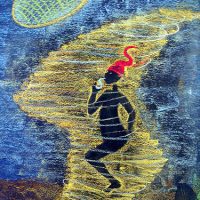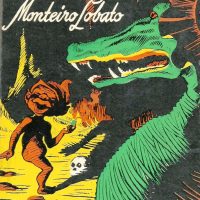Saci : The One Legged Trickster
Listen
At a glance
| Description | |
|---|---|
| Origin | Brazilian Mythology |
| Classification | Spirits |
| Family Members | N/A |
| Region | Brazil |
| Associated With | Mischief, Trickery |
Saci
Introduction
Saci, also known as Saci-Pererê, is one of the most beloved and mischievous figures in Brazilian folklore. Rooted in a fusion of Indigenous Tupi-Guarani traditions, African mythologies brought through the transatlantic slave trade, and European storytelling, Saci reflects Brazil’s multicultural history. He is celebrated as a trickster spirit who both entertains and unsettles, embodying freedom, defiance, and humor. Popularized in the early 20th century by the Brazilian writer Monteiro Lobato, Saci has since become a cultural icon, immortalized in literature, oral traditions, media, and even national celebrations. His legend endures as a reminder of Brazil’s complex heritage and the enduring power of folklore in shaping identity.
Physical Traits
Saci is almost always described as a one-legged boy, a trait that paradoxically enhances rather than hinders his agility. He is able to leap great distances, run at extraordinary speeds, and vanish in whirlwinds. Traditionally, he is depicted as dark-skinned, usually with African features, which connects his image to the memory of slavery in Brazil. His red cap is his most defining accessory, imbued with magical powers that allow him to teleport, turn invisible, and manipulate the wind. He is also recognized by his ever-present smoking pipe, a detail that marks him as both playful and rebellious. In some accounts, Saci bears holes in the palms of his hands or fiery red eyes, depending on the regional variation. Despite his small size, often described as no taller than half a meter, he possesses an imposing aura that commands attention.
Family
Unlike deities or heroes in mythologies that often have established genealogies, Saci does not belong to a divine family tree. Instead, he is part of a folkloric lineage of spirits that vary by region and oral tradition. His origins are traced back to the Tupi-Guarani myth of Ŷaci-ŷaterê, a magical red-haired child who, like Saci, was known for trickery. Over time, the Indigenous figure blended with African spiritual concepts, creating the version of Saci that became a national symbol. While he is not linked to kinship in the traditional sense, some storytellers describe “species” of Sacis—different forms that share the same essence but differ in personality and appearance. These variations highlight the adaptability of the character within Brazil’s diverse cultural regions, demonstrating that Saci belongs more to a mythological continuum than to a single family.
Other names
The trickster is most famously known as Saci-Pererê, but across Brazil, he carries other names that reflect regional storytelling. Variants such as Saci-Trique and Saci-Saçurá reveal how oral tradition reshaped the legend as it traveled. In northern Brazil, he is sometimes linked to the Matinta-Pereira, a female spirit that can transform into a bird, suggesting a feminized adaptation of his myth. Scholars believe that the name “Saci” may derive from Tupi words meaning “leaping” or “evil eye,” both of which suit his mischievous nature. These diverse names illustrate the fluidity of folklore, where a single figure can take multiple forms while retaining its cultural essence.
Powers and Abilities
Saci is known for an impressive range of supernatural abilities, all of which align with his trickster identity. His magical red cap grants him invisibility, teleportation, and control over whirlwinds, allowing him to appear and disappear unpredictably. He can also shape-shift into a bird, most often the Matinta-Pereira, whose haunting song is said to come from nowhere. Saci’s speed is legendary; despite having only one leg, he can outrun horses and disappear into the forest before anyone can catch him.
His mischief is legendary in rural Brazil. Farmers tell stories of Saci souring fresh milk, tangling horses’ manes, hiding household objects, or causing sewing needles to go dull. He is also blamed for eggs that fail to hatch or for nightmares that disturb people’s sleep. In some tales, capturing Saci requires trapping him inside a bottle or stealing his red cap, after which he may grant wishes to earn his freedom. Despite his antics, Saci’s tricks often serve a deeper purpose: he is portrayed as a guardian of nature, protecting forests and herbs from careless human exploitation. In this way, his role is both playful and ecological, reminding people to respect the natural world.
Modern Day Influence
In contemporary Brazil, Saci has become a symbol of cultural pride and resilience. Thanks to Monteiro Lobato’s stories, particularly O Saci (1921) and O Saci-Pererê – Resultado de um Inquérito (1918), the trickster entered the canon of national literature and was introduced to younger audiences. These works collected dozens of versions of the myth, preserving its richness and solidifying Saci’s status as a cultural icon. Today, Saci is celebrated every October 31st during Dia do Saci, a festival created as a local alternative to Halloween, emphasizing Brazilian folklore over imported traditions.
Saci continues to inspire Brazilian media, appearing in comics, television shows, films, and children’s books. Modern adaptations often depict him as a playful antihero rather than a frightening spirit, which has helped maintain his appeal for younger generations. Educational projects also use Saci as a cultural ambassador, introducing children to folklore through stories, games, and even augmented reality technology. His figure is being incorporated into classrooms, where interactive media present him as a fun way to explore heritage and values.
Culturally, Saci represents more than just mischief. His one leg has been interpreted as a metaphor for the scars of colonialism and slavery, while his defiant personality symbolizes resistance to authority. In this sense, he is not merely a prankster but also a figure of cultural resistance and memory. His lasting popularity demonstrates how folklore adapts to modern times without losing its symbolic power.
Related Images
Source
Wikipedia contributors. (n.d.). Saci (Brazilian folklore). Wikipedia. Retrieved September 22, 2025, from https://en.wikipedia.org/wiki/Saci_%28Brazilian_folklore%29
Faria, D. (2020, July 2). Racism & Folklore: Meet Saci-Pererê, the Brazilian Folklore Superstar. Folklore Thursday. Retrieved from https://folklorethursday.com/legends/meet-saci-perere-the-brazilian-folklore-superstar/
Myth and Folklore Wiki contributors. (n.d.). Saci. Myth and Folklore Wiki. Retrieved September 22, 2025, from https://mythus.fandom.com/wiki/Saci
Contributors to Villains Wiki. (n.d.). Saci (folklore) – Villains Wiki – Fandom. https://villains.fandom.com/wiki/Saci_(folklore)
Frequently Asked Questions
What is lorem Ipsum?
I am text block. Click edit button to change this text. Lorem ipsum dolor sit amet, consectetur adipiscing elit. Ut elit tellus, luctus nec ullamcorper mattis, pulvinar dapibus leo.
What is lorem Ipsum?
I am text block. Click edit button to change this text. Lorem ipsum dolor sit amet, consectetur adipiscing elit. Ut elit tellus, luctus nec ullamcorper mattis, pulvinar dapibus leo.
What is lorem Ipsum?
I am text block. Click edit button to change this text. Lorem ipsum dolor sit amet, consectetur adipiscing elit. Ut elit tellus, luctus nec ullamcorper mattis, pulvinar dapibus leo.
What is lorem Ipsum?
I am text block. Click edit button to change this text. Lorem ipsum dolor sit amet, consectetur adipiscing elit. Ut elit tellus, luctus nec ullamcorper mattis, pulvinar dapibus leo.
What is lorem Ipsum?
I am text block. Click edit button to change this text. Lorem ipsum dolor sit amet, consectetur adipiscing elit. Ut elit tellus, luctus nec ullamcorper mattis, pulvinar dapibus leo.











